ITECH7400: Analysis of ITSM and ITIL Constraints and Frameworks
VerifiedAdded on 2022/11/25
|21
|4578
|233
Report
AI Summary
This report provides a detailed analysis of IT Service Management (ITSM) and IT Infrastructure Library (ITIL) frameworks, covering key concepts and constraints across seven weeks of study. The report begins with an introduction to ITSM and ITIL, defining core components, service lifecycles, and service management models. It then delves into specific modules, including service strategy, design, transition, and operation, along with continual service improvement. Further modules explore financial and capacity management, information security, and problem management. The report concludes with a discussion of measurement, metrics, and the Deming cycle. Each section outlines the processes, challenges, and objectives within the ITIL framework, providing a comprehensive overview of IT service management principles and practices.
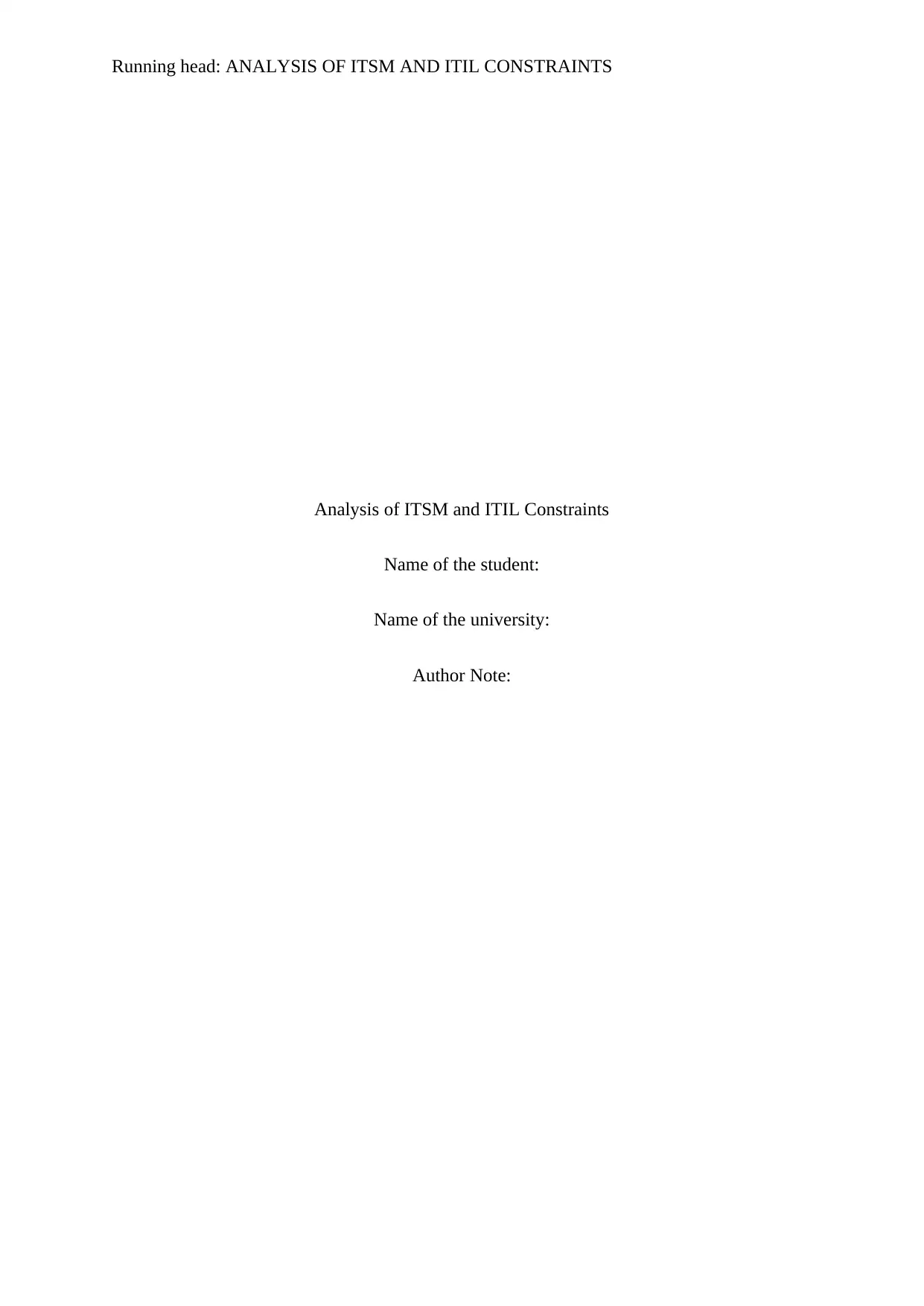
Running head: ANALYSIS OF ITSM AND ITIL CONSTRAINTS
Analysis of ITSM and ITIL Constraints
Name of the student:
Name of the university:
Author Note:
Analysis of ITSM and ITIL Constraints
Name of the student:
Name of the university:
Author Note:
Paraphrase This Document
Need a fresh take? Get an instant paraphrase of this document with our AI Paraphraser
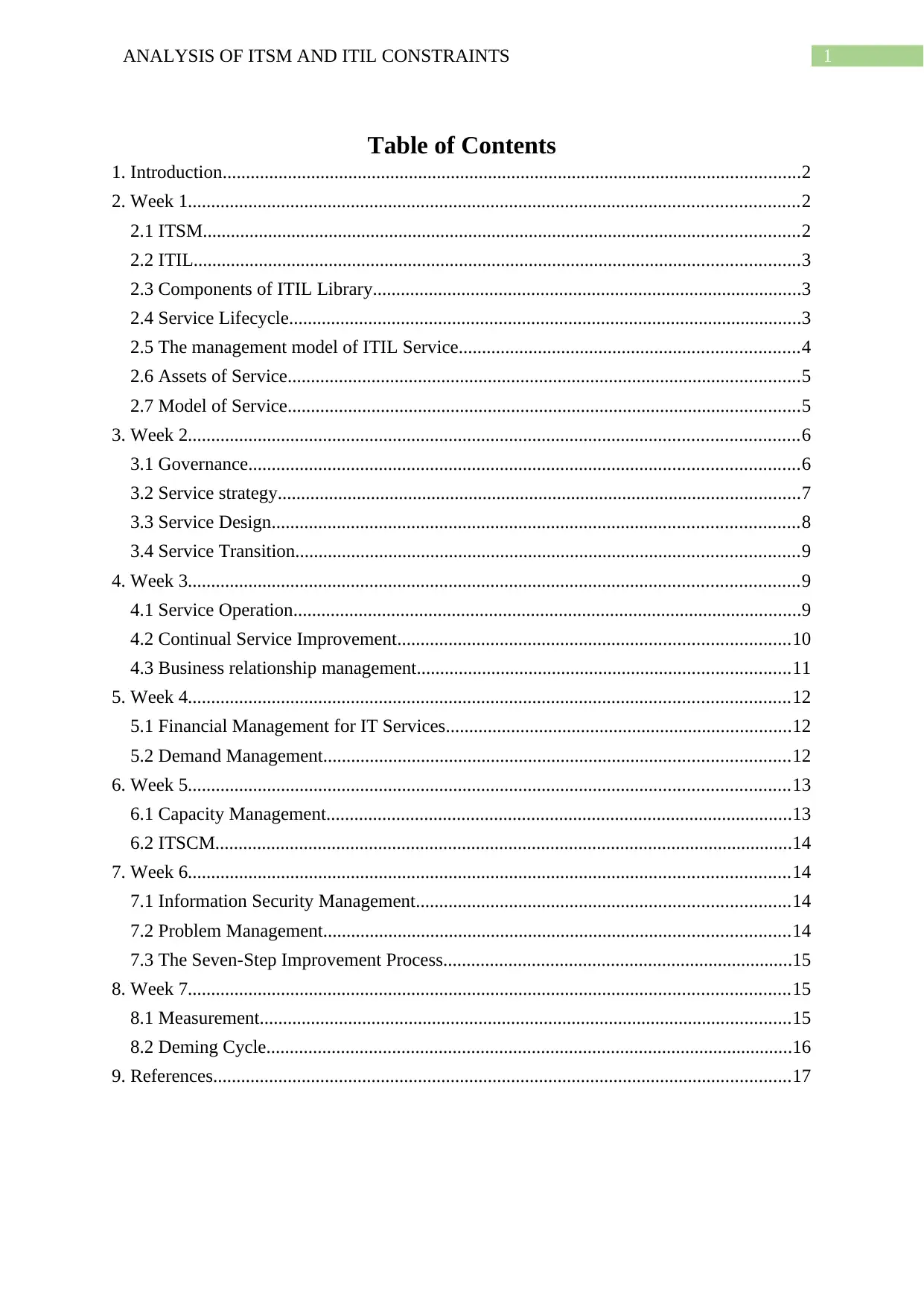
1ANALYSIS OF ITSM AND ITIL CONSTRAINTS
Table of Contents
1. Introduction............................................................................................................................2
2. Week 1...................................................................................................................................2
2.1 ITSM................................................................................................................................2
2.2 ITIL..................................................................................................................................3
2.3 Components of ITIL Library............................................................................................3
2.4 Service Lifecycle..............................................................................................................3
2.5 The management model of ITIL Service.........................................................................4
2.6 Assets of Service..............................................................................................................5
2.7 Model of Service..............................................................................................................5
3. Week 2...................................................................................................................................6
3.1 Governance......................................................................................................................6
3.2 Service strategy................................................................................................................7
3.3 Service Design.................................................................................................................8
3.4 Service Transition............................................................................................................9
4. Week 3...................................................................................................................................9
4.1 Service Operation.............................................................................................................9
4.2 Continual Service Improvement....................................................................................10
4.3 Business relationship management................................................................................11
5. Week 4.................................................................................................................................12
5.1 Financial Management for IT Services..........................................................................12
5.2 Demand Management....................................................................................................12
6. Week 5.................................................................................................................................13
6.1 Capacity Management....................................................................................................13
6.2 ITSCM............................................................................................................................14
7. Week 6.................................................................................................................................14
7.1 Information Security Management................................................................................14
7.2 Problem Management....................................................................................................14
7.3 The Seven-Step Improvement Process...........................................................................15
8. Week 7.................................................................................................................................15
8.1 Measurement..................................................................................................................15
8.2 Deming Cycle.................................................................................................................16
9. References............................................................................................................................17
Table of Contents
1. Introduction............................................................................................................................2
2. Week 1...................................................................................................................................2
2.1 ITSM................................................................................................................................2
2.2 ITIL..................................................................................................................................3
2.3 Components of ITIL Library............................................................................................3
2.4 Service Lifecycle..............................................................................................................3
2.5 The management model of ITIL Service.........................................................................4
2.6 Assets of Service..............................................................................................................5
2.7 Model of Service..............................................................................................................5
3. Week 2...................................................................................................................................6
3.1 Governance......................................................................................................................6
3.2 Service strategy................................................................................................................7
3.3 Service Design.................................................................................................................8
3.4 Service Transition............................................................................................................9
4. Week 3...................................................................................................................................9
4.1 Service Operation.............................................................................................................9
4.2 Continual Service Improvement....................................................................................10
4.3 Business relationship management................................................................................11
5. Week 4.................................................................................................................................12
5.1 Financial Management for IT Services..........................................................................12
5.2 Demand Management....................................................................................................12
6. Week 5.................................................................................................................................13
6.1 Capacity Management....................................................................................................13
6.2 ITSCM............................................................................................................................14
7. Week 6.................................................................................................................................14
7.1 Information Security Management................................................................................14
7.2 Problem Management....................................................................................................14
7.3 The Seven-Step Improvement Process...........................................................................15
8. Week 7.................................................................................................................................15
8.1 Measurement..................................................................................................................15
8.2 Deming Cycle.................................................................................................................16
9. References............................................................................................................................17

2ANALYSIS OF ITSM AND ITIL CONSTRAINTS
⊘ This is a preview!⊘
Do you want full access?
Subscribe today to unlock all pages.

Trusted by 1+ million students worldwide
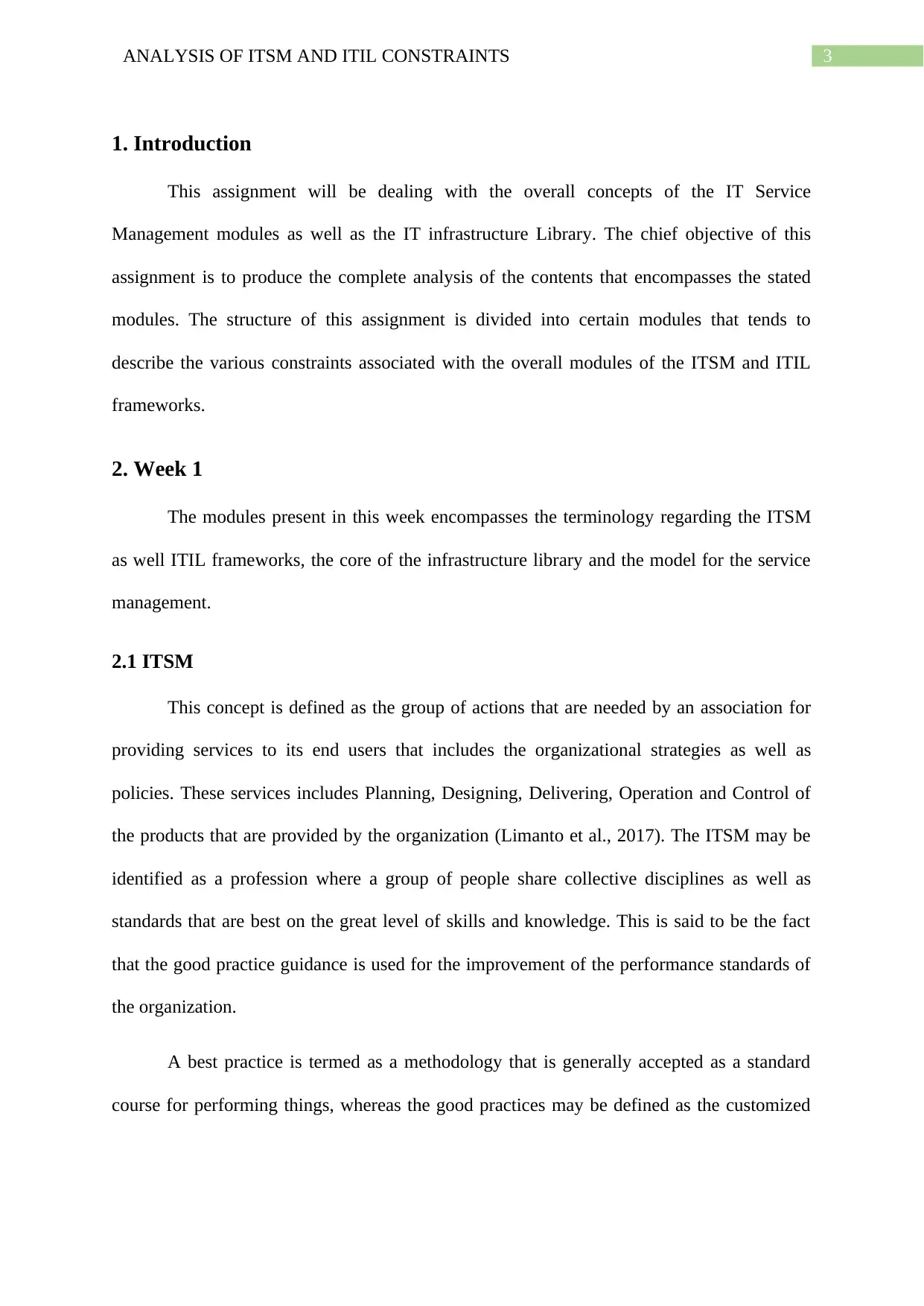
3ANALYSIS OF ITSM AND ITIL CONSTRAINTS
1. Introduction
This assignment will be dealing with the overall concepts of the IT Service
Management modules as well as the IT infrastructure Library. The chief objective of this
assignment is to produce the complete analysis of the contents that encompasses the stated
modules. The structure of this assignment is divided into certain modules that tends to
describe the various constraints associated with the overall modules of the ITSM and ITIL
frameworks.
2. Week 1
The modules present in this week encompasses the terminology regarding the ITSM
as well ITIL frameworks, the core of the infrastructure library and the model for the service
management.
2.1 ITSM
This concept is defined as the group of actions that are needed by an association for
providing services to its end users that includes the organizational strategies as well as
policies. These services includes Planning, Designing, Delivering, Operation and Control of
the products that are provided by the organization (Limanto et al., 2017). The ITSM may be
identified as a profession where a group of people share collective disciplines as well as
standards that are best on the great level of skills and knowledge. This is said to be the fact
that the good practice guidance is used for the improvement of the performance standards of
the organization.
A best practice is termed as a methodology that is generally accepted as a standard
course for performing things, whereas the good practices may be defined as the customized
1. Introduction
This assignment will be dealing with the overall concepts of the IT Service
Management modules as well as the IT infrastructure Library. The chief objective of this
assignment is to produce the complete analysis of the contents that encompasses the stated
modules. The structure of this assignment is divided into certain modules that tends to
describe the various constraints associated with the overall modules of the ITSM and ITIL
frameworks.
2. Week 1
The modules present in this week encompasses the terminology regarding the ITSM
as well ITIL frameworks, the core of the infrastructure library and the model for the service
management.
2.1 ITSM
This concept is defined as the group of actions that are needed by an association for
providing services to its end users that includes the organizational strategies as well as
policies. These services includes Planning, Designing, Delivering, Operation and Control of
the products that are provided by the organization (Limanto et al., 2017). The ITSM may be
identified as a profession where a group of people share collective disciplines as well as
standards that are best on the great level of skills and knowledge. This is said to be the fact
that the good practice guidance is used for the improvement of the performance standards of
the organization.
A best practice is termed as a methodology that is generally accepted as a standard
course for performing things, whereas the good practices may be defined as the customized
Paraphrase This Document
Need a fresh take? Get an instant paraphrase of this document with our AI Paraphraser
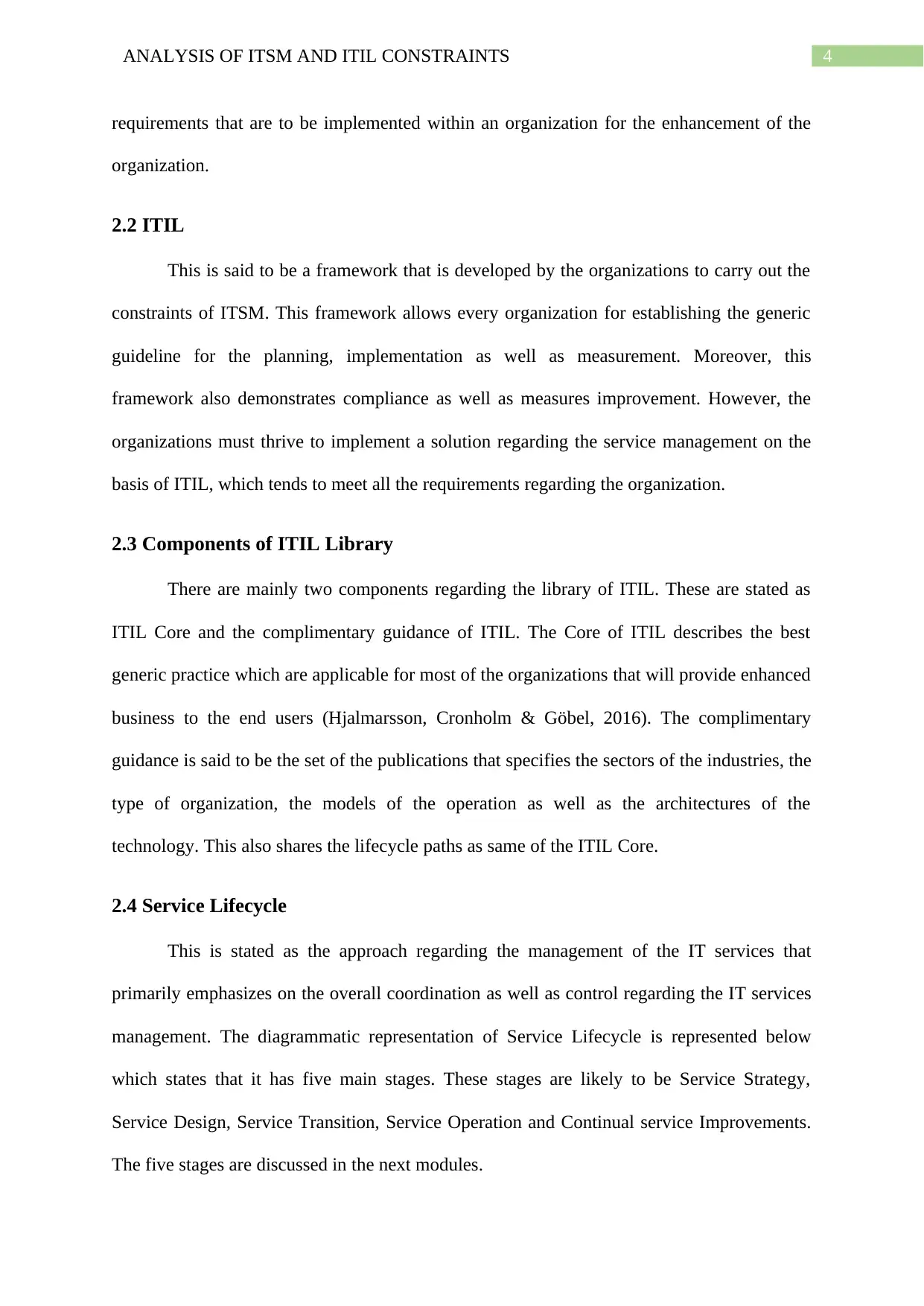
4ANALYSIS OF ITSM AND ITIL CONSTRAINTS
requirements that are to be implemented within an organization for the enhancement of the
organization.
2.2 ITIL
This is said to be a framework that is developed by the organizations to carry out the
constraints of ITSM. This framework allows every organization for establishing the generic
guideline for the planning, implementation as well as measurement. Moreover, this
framework also demonstrates compliance as well as measures improvement. However, the
organizations must thrive to implement a solution regarding the service management on the
basis of ITIL, which tends to meet all the requirements regarding the organization.
2.3 Components of ITIL Library
There are mainly two components regarding the library of ITIL. These are stated as
ITIL Core and the complimentary guidance of ITIL. The Core of ITIL describes the best
generic practice which are applicable for most of the organizations that will provide enhanced
business to the end users (Hjalmarsson, Cronholm & Göbel, 2016). The complimentary
guidance is said to be the set of the publications that specifies the sectors of the industries, the
type of organization, the models of the operation as well as the architectures of the
technology. This also shares the lifecycle paths as same of the ITIL Core.
2.4 Service Lifecycle
This is stated as the approach regarding the management of the IT services that
primarily emphasizes on the overall coordination as well as control regarding the IT services
management. The diagrammatic representation of Service Lifecycle is represented below
which states that it has five main stages. These stages are likely to be Service Strategy,
Service Design, Service Transition, Service Operation and Continual service Improvements.
The five stages are discussed in the next modules.
requirements that are to be implemented within an organization for the enhancement of the
organization.
2.2 ITIL
This is said to be a framework that is developed by the organizations to carry out the
constraints of ITSM. This framework allows every organization for establishing the generic
guideline for the planning, implementation as well as measurement. Moreover, this
framework also demonstrates compliance as well as measures improvement. However, the
organizations must thrive to implement a solution regarding the service management on the
basis of ITIL, which tends to meet all the requirements regarding the organization.
2.3 Components of ITIL Library
There are mainly two components regarding the library of ITIL. These are stated as
ITIL Core and the complimentary guidance of ITIL. The Core of ITIL describes the best
generic practice which are applicable for most of the organizations that will provide enhanced
business to the end users (Hjalmarsson, Cronholm & Göbel, 2016). The complimentary
guidance is said to be the set of the publications that specifies the sectors of the industries, the
type of organization, the models of the operation as well as the architectures of the
technology. This also shares the lifecycle paths as same of the ITIL Core.
2.4 Service Lifecycle
This is stated as the approach regarding the management of the IT services that
primarily emphasizes on the overall coordination as well as control regarding the IT services
management. The diagrammatic representation of Service Lifecycle is represented below
which states that it has five main stages. These stages are likely to be Service Strategy,
Service Design, Service Transition, Service Operation and Continual service Improvements.
The five stages are discussed in the next modules.
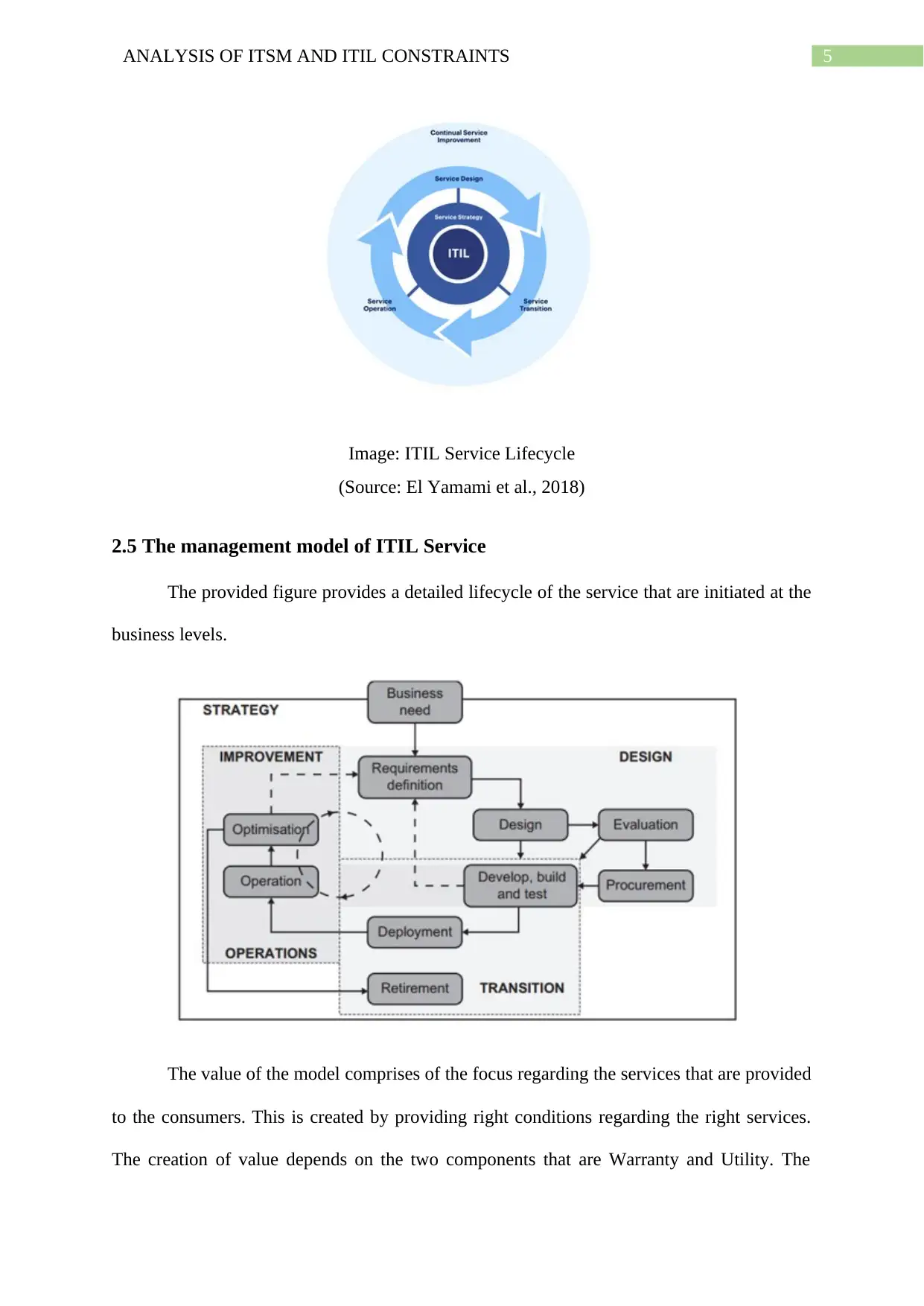
5ANALYSIS OF ITSM AND ITIL CONSTRAINTS
Image: ITIL Service Lifecycle
(Source: El Yamami et al., 2018)
2.5 The management model of ITIL Service
The provided figure provides a detailed lifecycle of the service that are initiated at the
business levels.
The value of the model comprises of the focus regarding the services that are provided
to the consumers. This is created by providing right conditions regarding the right services.
The creation of value depends on the two components that are Warranty and Utility. The
Image: ITIL Service Lifecycle
(Source: El Yamami et al., 2018)
2.5 The management model of ITIL Service
The provided figure provides a detailed lifecycle of the service that are initiated at the
business levels.
The value of the model comprises of the focus regarding the services that are provided
to the consumers. This is created by providing right conditions regarding the right services.
The creation of value depends on the two components that are Warranty and Utility. The
⊘ This is a preview!⊘
Do you want full access?
Subscribe today to unlock all pages.

Trusted by 1+ million students worldwide
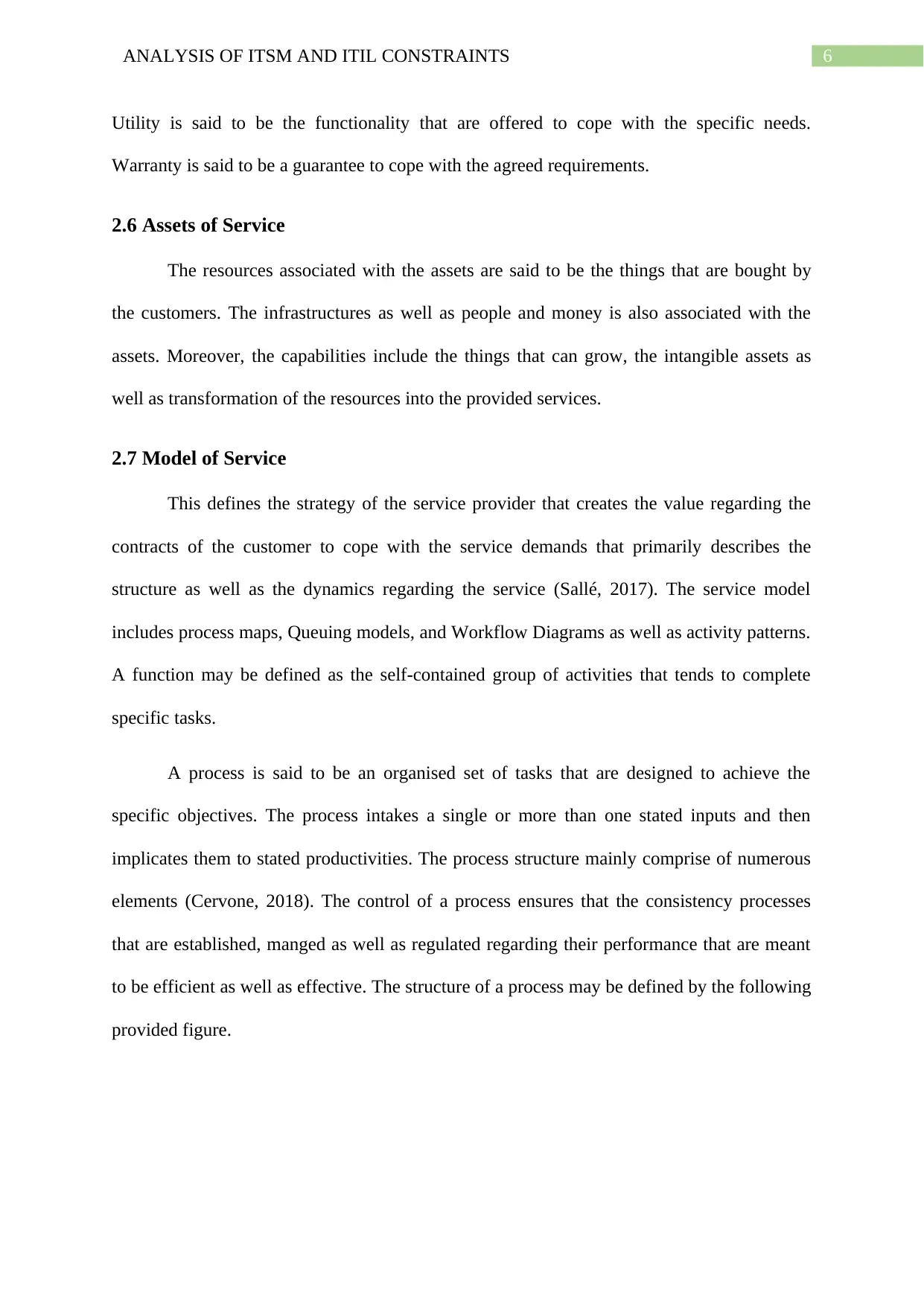
6ANALYSIS OF ITSM AND ITIL CONSTRAINTS
Utility is said to be the functionality that are offered to cope with the specific needs.
Warranty is said to be a guarantee to cope with the agreed requirements.
2.6 Assets of Service
The resources associated with the assets are said to be the things that are bought by
the customers. The infrastructures as well as people and money is also associated with the
assets. Moreover, the capabilities include the things that can grow, the intangible assets as
well as transformation of the resources into the provided services.
2.7 Model of Service
This defines the strategy of the service provider that creates the value regarding the
contracts of the customer to cope with the service demands that primarily describes the
structure as well as the dynamics regarding the service (Sallé, 2017). The service model
includes process maps, Queuing models, and Workflow Diagrams as well as activity patterns.
A function may be defined as the self-contained group of activities that tends to complete
specific tasks.
A process is said to be an organised set of tasks that are designed to achieve the
specific objectives. The process intakes a single or more than one stated inputs and then
implicates them to stated productivities. The process structure mainly comprise of numerous
elements (Cervone, 2018). The control of a process ensures that the consistency processes
that are established, manged as well as regulated regarding their performance that are meant
to be efficient as well as effective. The structure of a process may be defined by the following
provided figure.
Utility is said to be the functionality that are offered to cope with the specific needs.
Warranty is said to be a guarantee to cope with the agreed requirements.
2.6 Assets of Service
The resources associated with the assets are said to be the things that are bought by
the customers. The infrastructures as well as people and money is also associated with the
assets. Moreover, the capabilities include the things that can grow, the intangible assets as
well as transformation of the resources into the provided services.
2.7 Model of Service
This defines the strategy of the service provider that creates the value regarding the
contracts of the customer to cope with the service demands that primarily describes the
structure as well as the dynamics regarding the service (Sallé, 2017). The service model
includes process maps, Queuing models, and Workflow Diagrams as well as activity patterns.
A function may be defined as the self-contained group of activities that tends to complete
specific tasks.
A process is said to be an organised set of tasks that are designed to achieve the
specific objectives. The process intakes a single or more than one stated inputs and then
implicates them to stated productivities. The process structure mainly comprise of numerous
elements (Cervone, 2018). The control of a process ensures that the consistency processes
that are established, manged as well as regulated regarding their performance that are meant
to be efficient as well as effective. The structure of a process may be defined by the following
provided figure.
Paraphrase This Document
Need a fresh take? Get an instant paraphrase of this document with our AI Paraphraser
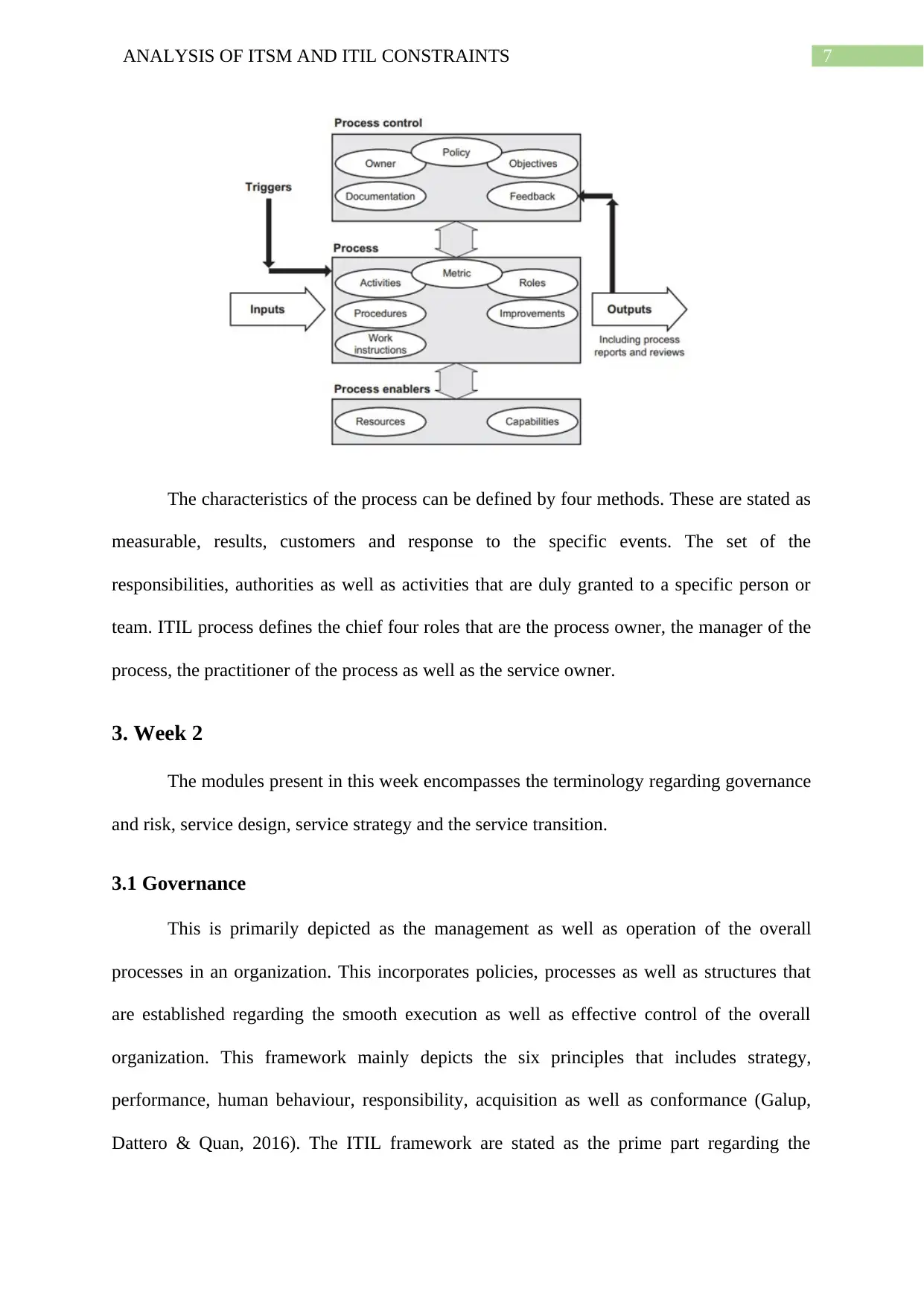
7ANALYSIS OF ITSM AND ITIL CONSTRAINTS
The characteristics of the process can be defined by four methods. These are stated as
measurable, results, customers and response to the specific events. The set of the
responsibilities, authorities as well as activities that are duly granted to a specific person or
team. ITIL process defines the chief four roles that are the process owner, the manager of the
process, the practitioner of the process as well as the service owner.
3. Week 2
The modules present in this week encompasses the terminology regarding governance
and risk, service design, service strategy and the service transition.
3.1 Governance
This is primarily depicted as the management as well as operation of the overall
processes in an organization. This incorporates policies, processes as well as structures that
are established regarding the smooth execution as well as effective control of the overall
organization. This framework mainly depicts the six principles that includes strategy,
performance, human behaviour, responsibility, acquisition as well as conformance (Galup,
Dattero & Quan, 2016). The ITIL framework are stated as the prime part regarding the
The characteristics of the process can be defined by four methods. These are stated as
measurable, results, customers and response to the specific events. The set of the
responsibilities, authorities as well as activities that are duly granted to a specific person or
team. ITIL process defines the chief four roles that are the process owner, the manager of the
process, the practitioner of the process as well as the service owner.
3. Week 2
The modules present in this week encompasses the terminology regarding governance
and risk, service design, service strategy and the service transition.
3.1 Governance
This is primarily depicted as the management as well as operation of the overall
processes in an organization. This incorporates policies, processes as well as structures that
are established regarding the smooth execution as well as effective control of the overall
organization. This framework mainly depicts the six principles that includes strategy,
performance, human behaviour, responsibility, acquisition as well as conformance (Galup,
Dattero & Quan, 2016). The ITIL framework are stated as the prime part regarding the
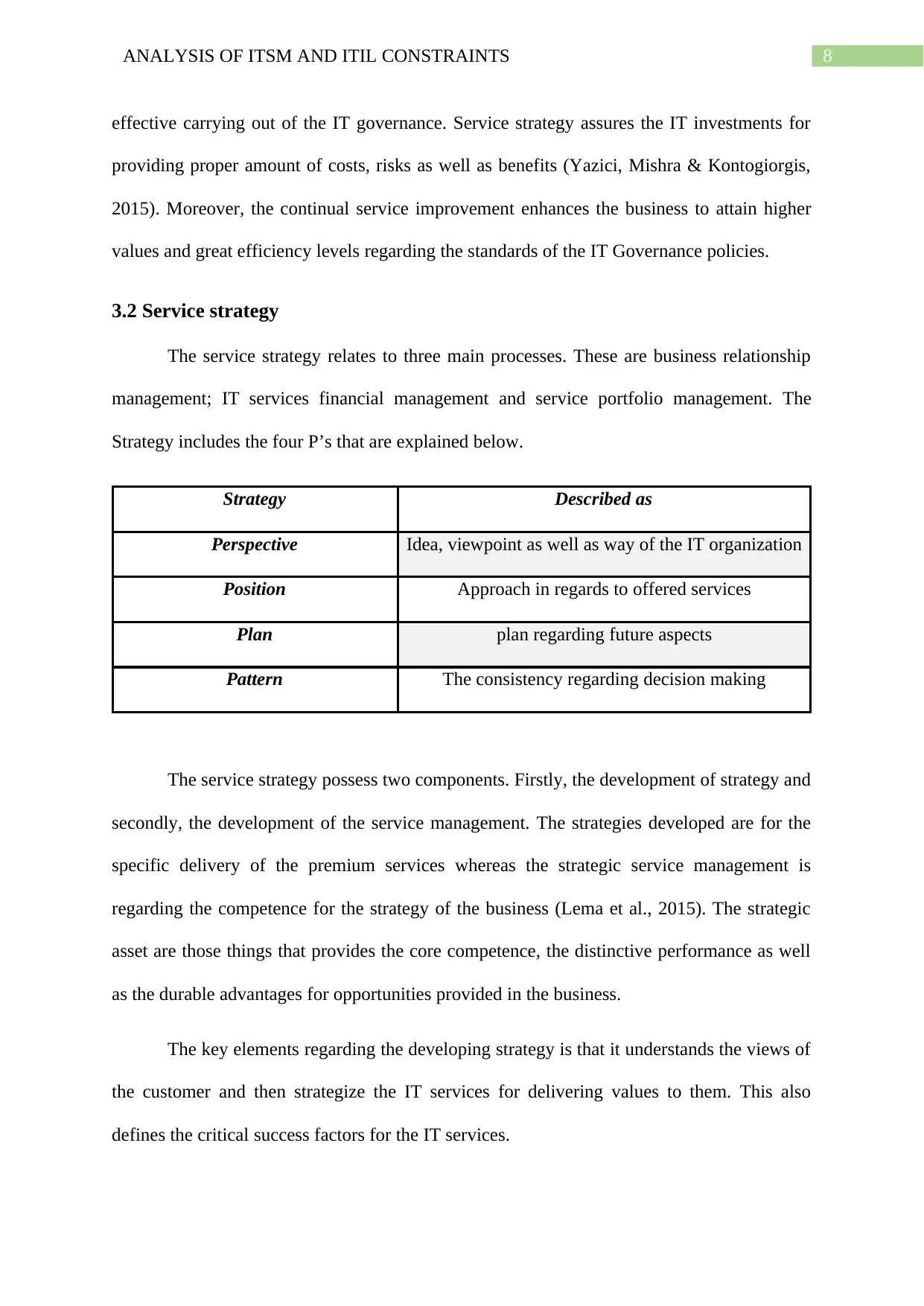
8ANALYSIS OF ITSM AND ITIL CONSTRAINTS
effective carrying out of the IT governance. Service strategy assures the IT investments for
providing proper amount of costs, risks as well as benefits (Yazici, Mishra & Kontogiorgis,
2015). Moreover, the continual service improvement enhances the business to attain higher
values and great efficiency levels regarding the standards of the IT Governance policies.
3.2 Service strategy
The service strategy relates to three main processes. These are business relationship
management; IT services financial management and service portfolio management. The
Strategy includes the four P’s that are explained below.
Strategy Described as
Perspective Idea, viewpoint as well as way of the IT organization
Position Approach in regards to offered services
Plan plan regarding future aspects
Pattern The consistency regarding decision making
The service strategy possess two components. Firstly, the development of strategy and
secondly, the development of the service management. The strategies developed are for the
specific delivery of the premium services whereas the strategic service management is
regarding the competence for the strategy of the business (Lema et al., 2015). The strategic
asset are those things that provides the core competence, the distinctive performance as well
as the durable advantages for opportunities provided in the business.
The key elements regarding the developing strategy is that it understands the views of
the customer and then strategize the IT services for delivering values to them. This also
defines the critical success factors for the IT services.
effective carrying out of the IT governance. Service strategy assures the IT investments for
providing proper amount of costs, risks as well as benefits (Yazici, Mishra & Kontogiorgis,
2015). Moreover, the continual service improvement enhances the business to attain higher
values and great efficiency levels regarding the standards of the IT Governance policies.
3.2 Service strategy
The service strategy relates to three main processes. These are business relationship
management; IT services financial management and service portfolio management. The
Strategy includes the four P’s that are explained below.
Strategy Described as
Perspective Idea, viewpoint as well as way of the IT organization
Position Approach in regards to offered services
Plan plan regarding future aspects
Pattern The consistency regarding decision making
The service strategy possess two components. Firstly, the development of strategy and
secondly, the development of the service management. The strategies developed are for the
specific delivery of the premium services whereas the strategic service management is
regarding the competence for the strategy of the business (Lema et al., 2015). The strategic
asset are those things that provides the core competence, the distinctive performance as well
as the durable advantages for opportunities provided in the business.
The key elements regarding the developing strategy is that it understands the views of
the customer and then strategize the IT services for delivering values to them. This also
defines the critical success factors for the IT services.
⊘ This is a preview!⊘
Do you want full access?
Subscribe today to unlock all pages.

Trusted by 1+ million students worldwide
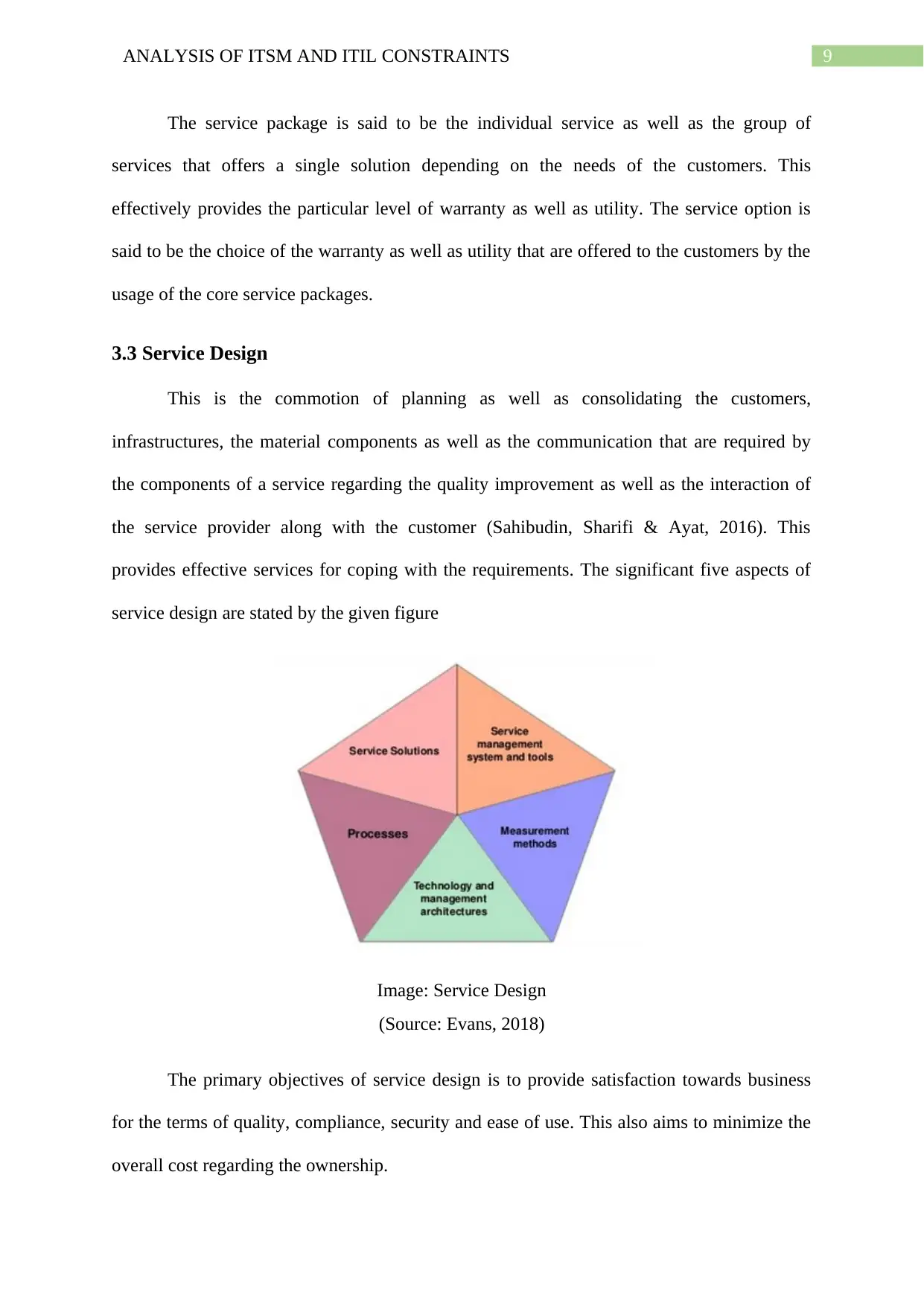
9ANALYSIS OF ITSM AND ITIL CONSTRAINTS
The service package is said to be the individual service as well as the group of
services that offers a single solution depending on the needs of the customers. This
effectively provides the particular level of warranty as well as utility. The service option is
said to be the choice of the warranty as well as utility that are offered to the customers by the
usage of the core service packages.
3.3 Service Design
This is the commotion of planning as well as consolidating the customers,
infrastructures, the material components as well as the communication that are required by
the components of a service regarding the quality improvement as well as the interaction of
the service provider along with the customer (Sahibudin, Sharifi & Ayat, 2016). This
provides effective services for coping with the requirements. The significant five aspects of
service design are stated by the given figure
Image: Service Design
(Source: Evans, 2018)
The primary objectives of service design is to provide satisfaction towards business
for the terms of quality, compliance, security and ease of use. This also aims to minimize the
overall cost regarding the ownership.
The service package is said to be the individual service as well as the group of
services that offers a single solution depending on the needs of the customers. This
effectively provides the particular level of warranty as well as utility. The service option is
said to be the choice of the warranty as well as utility that are offered to the customers by the
usage of the core service packages.
3.3 Service Design
This is the commotion of planning as well as consolidating the customers,
infrastructures, the material components as well as the communication that are required by
the components of a service regarding the quality improvement as well as the interaction of
the service provider along with the customer (Sahibudin, Sharifi & Ayat, 2016). This
provides effective services for coping with the requirements. The significant five aspects of
service design are stated by the given figure
Image: Service Design
(Source: Evans, 2018)
The primary objectives of service design is to provide satisfaction towards business
for the terms of quality, compliance, security and ease of use. This also aims to minimize the
overall cost regarding the ownership.
Paraphrase This Document
Need a fresh take? Get an instant paraphrase of this document with our AI Paraphraser
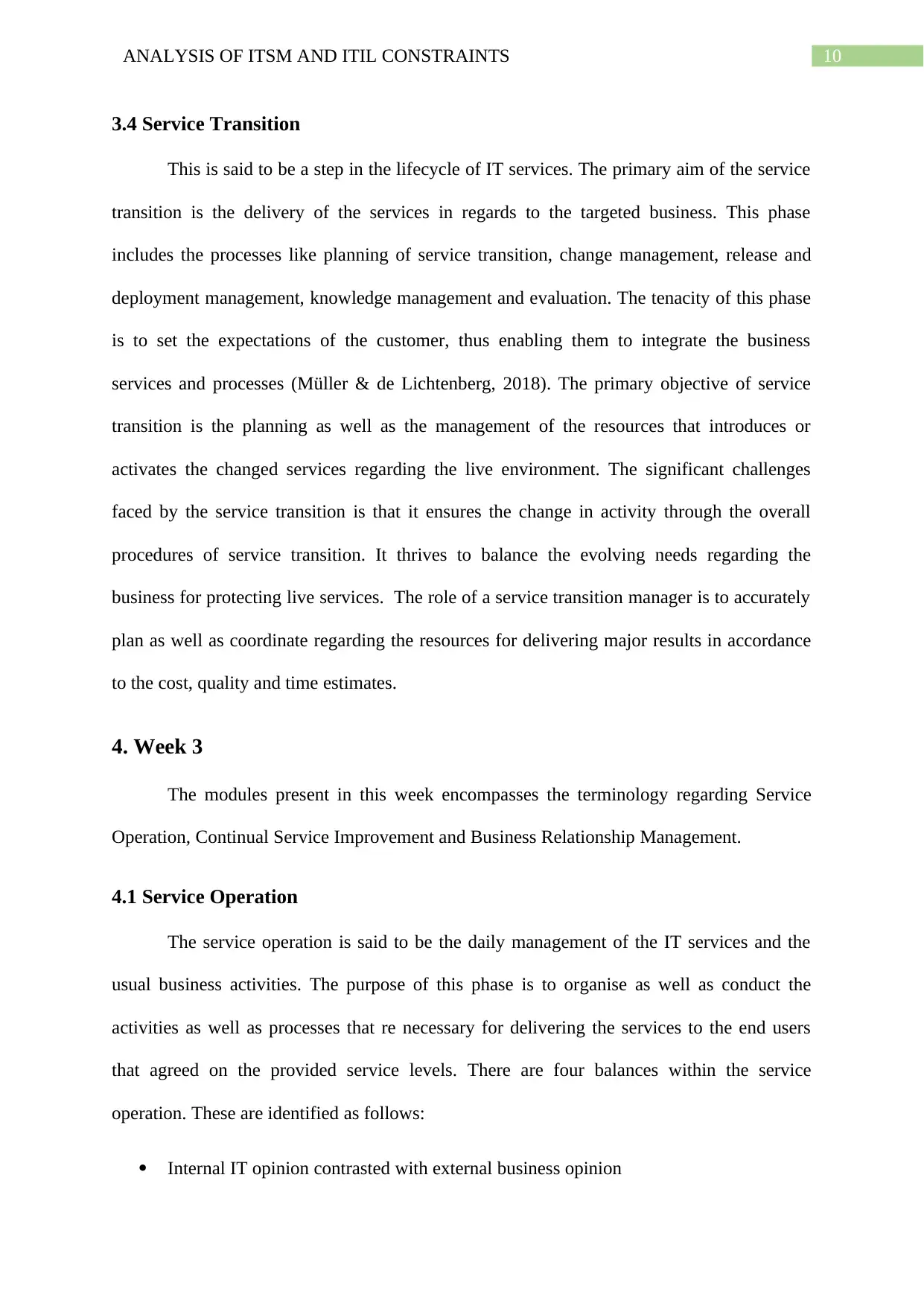
10ANALYSIS OF ITSM AND ITIL CONSTRAINTS
3.4 Service Transition
This is said to be a step in the lifecycle of IT services. The primary aim of the service
transition is the delivery of the services in regards to the targeted business. This phase
includes the processes like planning of service transition, change management, release and
deployment management, knowledge management and evaluation. The tenacity of this phase
is to set the expectations of the customer, thus enabling them to integrate the business
services and processes (Müller & de Lichtenberg, 2018). The primary objective of service
transition is the planning as well as the management of the resources that introduces or
activates the changed services regarding the live environment. The significant challenges
faced by the service transition is that it ensures the change in activity through the overall
procedures of service transition. It thrives to balance the evolving needs regarding the
business for protecting live services. The role of a service transition manager is to accurately
plan as well as coordinate regarding the resources for delivering major results in accordance
to the cost, quality and time estimates.
4. Week 3
The modules present in this week encompasses the terminology regarding Service
Operation, Continual Service Improvement and Business Relationship Management.
4.1 Service Operation
The service operation is said to be the daily management of the IT services and the
usual business activities. The purpose of this phase is to organise as well as conduct the
activities as well as processes that re necessary for delivering the services to the end users
that agreed on the provided service levels. There are four balances within the service
operation. These are identified as follows:
Internal IT opinion contrasted with external business opinion
3.4 Service Transition
This is said to be a step in the lifecycle of IT services. The primary aim of the service
transition is the delivery of the services in regards to the targeted business. This phase
includes the processes like planning of service transition, change management, release and
deployment management, knowledge management and evaluation. The tenacity of this phase
is to set the expectations of the customer, thus enabling them to integrate the business
services and processes (Müller & de Lichtenberg, 2018). The primary objective of service
transition is the planning as well as the management of the resources that introduces or
activates the changed services regarding the live environment. The significant challenges
faced by the service transition is that it ensures the change in activity through the overall
procedures of service transition. It thrives to balance the evolving needs regarding the
business for protecting live services. The role of a service transition manager is to accurately
plan as well as coordinate regarding the resources for delivering major results in accordance
to the cost, quality and time estimates.
4. Week 3
The modules present in this week encompasses the terminology regarding Service
Operation, Continual Service Improvement and Business Relationship Management.
4.1 Service Operation
The service operation is said to be the daily management of the IT services and the
usual business activities. The purpose of this phase is to organise as well as conduct the
activities as well as processes that re necessary for delivering the services to the end users
that agreed on the provided service levels. There are four balances within the service
operation. These are identified as follows:
Internal IT opinion contrasted with external business opinion
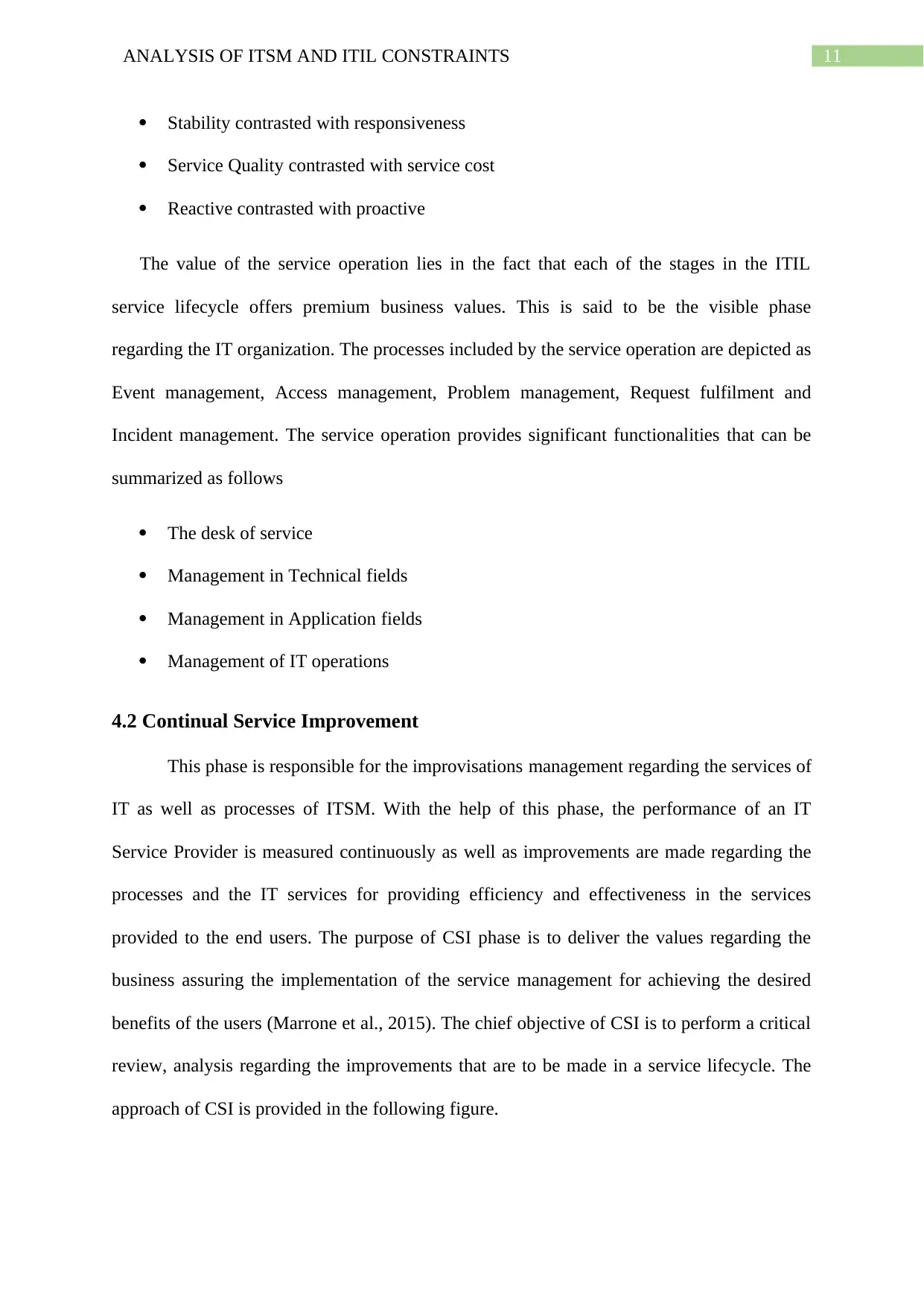
11ANALYSIS OF ITSM AND ITIL CONSTRAINTS
Stability contrasted with responsiveness
Service Quality contrasted with service cost
Reactive contrasted with proactive
The value of the service operation lies in the fact that each of the stages in the ITIL
service lifecycle offers premium business values. This is said to be the visible phase
regarding the IT organization. The processes included by the service operation are depicted as
Event management, Access management, Problem management, Request fulfilment and
Incident management. The service operation provides significant functionalities that can be
summarized as follows
The desk of service
Management in Technical fields
Management in Application fields
Management of IT operations
4.2 Continual Service Improvement
This phase is responsible for the improvisations management regarding the services of
IT as well as processes of ITSM. With the help of this phase, the performance of an IT
Service Provider is measured continuously as well as improvements are made regarding the
processes and the IT services for providing efficiency and effectiveness in the services
provided to the end users. The purpose of CSI phase is to deliver the values regarding the
business assuring the implementation of the service management for achieving the desired
benefits of the users (Marrone et al., 2015). The chief objective of CSI is to perform a critical
review, analysis regarding the improvements that are to be made in a service lifecycle. The
approach of CSI is provided in the following figure.
Stability contrasted with responsiveness
Service Quality contrasted with service cost
Reactive contrasted with proactive
The value of the service operation lies in the fact that each of the stages in the ITIL
service lifecycle offers premium business values. This is said to be the visible phase
regarding the IT organization. The processes included by the service operation are depicted as
Event management, Access management, Problem management, Request fulfilment and
Incident management. The service operation provides significant functionalities that can be
summarized as follows
The desk of service
Management in Technical fields
Management in Application fields
Management of IT operations
4.2 Continual Service Improvement
This phase is responsible for the improvisations management regarding the services of
IT as well as processes of ITSM. With the help of this phase, the performance of an IT
Service Provider is measured continuously as well as improvements are made regarding the
processes and the IT services for providing efficiency and effectiveness in the services
provided to the end users. The purpose of CSI phase is to deliver the values regarding the
business assuring the implementation of the service management for achieving the desired
benefits of the users (Marrone et al., 2015). The chief objective of CSI is to perform a critical
review, analysis regarding the improvements that are to be made in a service lifecycle. The
approach of CSI is provided in the following figure.
⊘ This is a preview!⊘
Do you want full access?
Subscribe today to unlock all pages.

Trusted by 1+ million students worldwide
1 out of 21
Related Documents
Your All-in-One AI-Powered Toolkit for Academic Success.
+13062052269
info@desklib.com
Available 24*7 on WhatsApp / Email
![[object Object]](/_next/static/media/star-bottom.7253800d.svg)
Unlock your academic potential
Copyright © 2020–2025 A2Z Services. All Rights Reserved. Developed and managed by ZUCOL.





